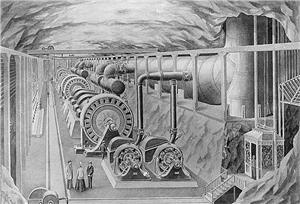On July 31, 1899, tiny 18-month-old Dorothy Baker throws the switch that starts the generators housed in the rock beneath Snoqualmie Falls, located in east King County. Electricity begins flowing to Seattle in the first long-distance transmission of hydroelectric power in the Northwest. The ceremony is held at the firm's Seattle station.
A Family Affair
Charles H. Baker was an engineer for the Seattle, Lake Shore & Eastern Railway, which traveled past the falls, and during his many sojourns above them, he began to see an amazing potential for the surging flow of water. After becoming unemployed in the economic Panic of 1893, he convinced his wealthy father, William T. Baker, to finance his idea of building a power generator deep within the rock beneath the falls.
William Baker was president of the Chicago Board of Trade. He had organized the 1893 World’s Columbian Exposition. Father and son considered themselves partners in the Snoqualmie Falls Power Plant, but everything was placed in William Baker’s name to keep creditors away from his son.
Work began in April 1898, and for the next few years the river was diverted from the southern side of the waterfall. A 270-foot long shaft was drilled into the rock, and through it equipment brought down. Later, an eight-foot diameter pipe to channel water through was placed in the shaft. The force of the falls drove four water wheels in a subterranean chamber, and this resulting energy was brought up through cables to a transformer house, where it was converted into 32,000 volts of electricity.
On July 31, 1899, at a public ceremony, Baker's 18-month-old daughter Dorothy pulled the switch to begin generating power. Electricity went from Snoqualmie Falls to a substation in Issaquah, then on to Renton where it was dispersed to Seattle and Tacoma. More than 100 years later, this equipment is still in operation.
Power Struggles
Baker’s competitors in the electricity business were Charles Stone and Edwin Webster, who owned generating plants in Seattle. When Baker began planning another plant in Tacoma, a smear campaign was generated, insinuating that Baker’s power was unreliable due to the distance it had to travel.
In 1903, the Snoqualmie plant suffered a disastrous fire, which destroyed much of the equipment, but the power plant was back on line in 36 hours. Baker believed that the fire was caused by arson. Later that year William T. Baker died, and since the power plant was in his name only, estate lawyers refused to recognize Charles Baker as a partner.
In 1908, the Snoqualmie Falls Power Company was sold to the Seattle-Tacoma Power Company, forerunner of Puget Sound Energy. The purchasers were Stone & Webster.

